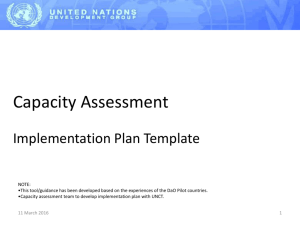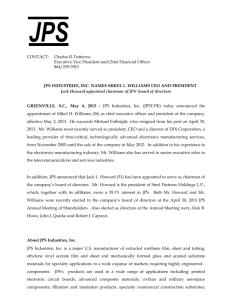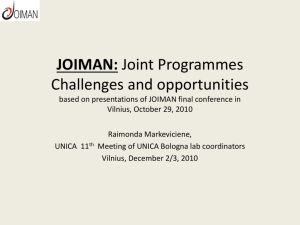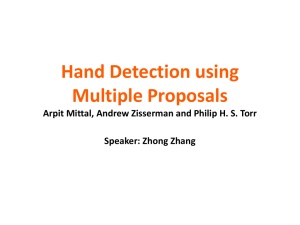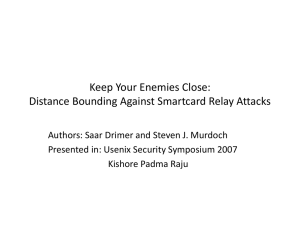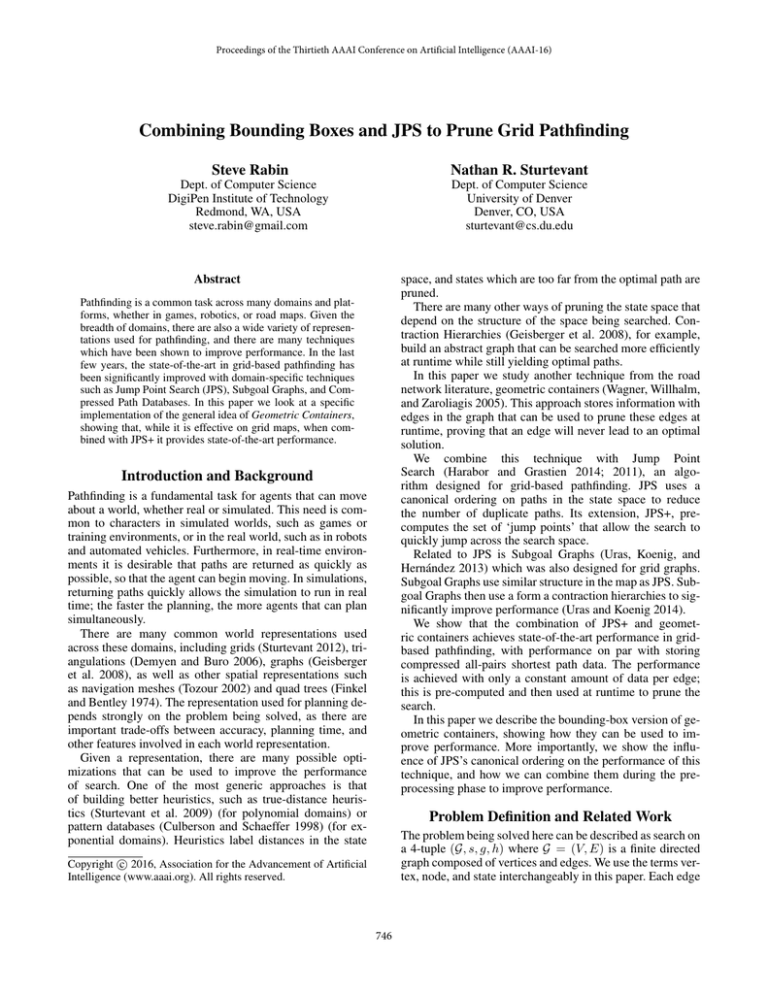
Proceedings of the Thirtieth AAAI Conference on Artificial Intelligence (AAAI-16)
Combining Bounding Boxes and JPS to Prune Grid Pathfinding
Steve Rabin
Nathan R. Sturtevant
Dept. of Computer Science
DigiPen Institute of Technology
Redmond, WA, USA
steve.rabin@gmail.com
Dept. of Computer Science
University of Denver
Denver, CO, USA
sturtevant@cs.du.edu
space, and states which are too far from the optimal path are
pruned.
There are many other ways of pruning the state space that
depend on the structure of the space being searched. Contraction Hierarchies (Geisberger et al. 2008), for example,
build an abstract graph that can be searched more efficiently
at runtime while still yielding optimal paths.
In this paper we study another technique from the road
network literature, geometric containers (Wagner, Willhalm,
and Zaroliagis 2005). This approach stores information with
edges in the graph that can be used to prune these edges at
runtime, proving that an edge will never lead to an optimal
solution.
We combine this technique with Jump Point
Search (Harabor and Grastien 2014; 2011), an algorithm designed for grid-based pathfinding. JPS uses a
canonical ordering on paths in the state space to reduce
the number of duplicate paths. Its extension, JPS+, precomputes the set of ‘jump points’ that allow the search to
quickly jump across the search space.
Related to JPS is Subgoal Graphs (Uras, Koenig, and
Hernández 2013) which was also designed for grid graphs.
Subgoal Graphs use similar structure in the map as JPS. Subgoal Graphs then use a form a contraction hierarchies to significantly improve performance (Uras and Koenig 2014).
We show that the combination of JPS+ and geometric containers achieves state-of-the-art performance in gridbased pathfinding, with performance on par with storing
compressed all-pairs shortest path data. The performance
is achieved with only a constant amount of data per edge;
this is pre-computed and then used at runtime to prune the
search.
In this paper we describe the bounding-box version of geometric containers, showing how they can be used to improve performance. More importantly, we show the influence of JPS’s canonical ordering on the performance of this
technique, and how we can combine them during the preprocessing phase to improve performance.
Abstract
Pathfinding is a common task across many domains and platforms, whether in games, robotics, or road maps. Given the
breadth of domains, there are also a wide variety of representations used for pathfinding, and there are many techniques
which have been shown to improve performance. In the last
few years, the state-of-the-art in grid-based pathfinding has
been significantly improved with domain-specific techniques
such as Jump Point Search (JPS), Subgoal Graphs, and Compressed Path Databases. In this paper we look at a specific
implementation of the general idea of Geometric Containers,
showing that, while it is effective on grid maps, when combined with JPS+ it provides state-of-the-art performance.
Introduction and Background
Pathfinding is a fundamental task for agents that can move
about a world, whether real or simulated. This need is common to characters in simulated worlds, such as games or
training environments, or in the real world, such as in robots
and automated vehicles. Furthermore, in real-time environments it is desirable that paths are returned as quickly as
possible, so that the agent can begin moving. In simulations,
returning paths quickly allows the simulation to run in real
time; the faster the planning, the more agents that can plan
simultaneously.
There are many common world representations used
across these domains, including grids (Sturtevant 2012), triangulations (Demyen and Buro 2006), graphs (Geisberger
et al. 2008), as well as other spatial representations such
as navigation meshes (Tozour 2002) and quad trees (Finkel
and Bentley 1974). The representation used for planning depends strongly on the problem being solved, as there are
important trade-offs between accuracy, planning time, and
other features involved in each world representation.
Given a representation, there are many possible optimizations that can be used to improve the performance
of search. One of the most generic approaches is that
of building better heuristics, such as true-distance heuristics (Sturtevant et al. 2009) (for polynomial domains) or
pattern databases (Culberson and Schaeffer 1998) (for exponential domains). Heuristics label distances in the state
Problem Definition and Related Work
The problem being solved here can be described as search on
a 4-tuple (G, s, g, h) where G = (V, E) is a finite directed
graph composed of vertices and edges. We use the terms vertex, node, and state interchangeably in this paper. Each edge
c 2016, Association for the Advancement of Artificial
Copyright Intelligence (www.aaai.org). All rights reserved.
746
Start
Goal
•
(a)
Figure 1: JPS search ordering
Goal
Pruned
•
(b)
Figure 2: Bounding box example.
e = (v1 , v2 ) ∈ E has a positive cost c(v1 , v2 ). In the graph,
s ∈ V is the start state, g ∈ V is the goal state, and h is
an admissible heuristic function where h(a, b) ≤ c∗ (a, b)
if c∗ is the optimal path cost between a and b. The goal
is to find a path P (v0 , vn ) = (v0 , v1 , v2 , . . . , vn ) such that
∀[i ∈ 0 . . . n − 1](vi , vi+1 ) ∈ E, v0 = s, and vn = g. The
n−1
cost of a path is c(P ) = i=0 c(vi , vi+1 ). We designate an
optimal path as P ∗ (v0 , vn ).
There are many metrics that can be used to evaluate the
resulting path, including how fast the path is produced and
how much precomputation is needed. There are other interesting metrics, such as path quality, but this paper is restricted to algorithms that return optimal paths.
This paper will look at the combination of two primary
techniques, Jump Point Search (JPS) and geometric containers, which we explain here in more detail.
and rail networks.
On grid maps, the bounding box version of geometric
containers1 can be conceptualized by the question, “If I leave
this grid square traveling downward, what is the furthest row
and column I can get to optimally?” If you know that leaving a node in a particular direction can only optimally reach
a bounded area defined by a min/max row and column, then
if the goal lies outside of the bounded area, there is no reason
to explore in that direction.
We illustrate this in Figure 2 with the ‘lak308d’ map from
the Moving AI repository of maps (Sturtevant 2012). Suppose that the start state is at the top of the map, marked by
a circle and an arrow in Figure 2(a), and that the goal is at
the bottom of the map, similarly marked. Finding the shortest path to this problem using an A* search will require expanding nearly every state in the entire map; these states are
shaded (red) in Figure 2(b).
In this example, the optimal path from the start to the goal
goes around the right side of the loop. Thus, for an action
that moves diagonally down and to the right from the start,
the bounding box is shown in the white box labeled ‘goal’.
An action that moves diagonally down and to the left will
have the goal bounds marked in gray (labeled ‘pruned’). As
the goal is not in this region, this and all similar actions will
be pruned and none of these states will be expanded.
Jump Point Search. JPS (Harabor and Grastien 2011) encompasses a set of techniques designed to speed search on
uniform cost grids. First, JPS defines a canonical ordering
over all actions to minimize the number of transpositions
during search. On an empty map JPS’s canonical ordering
will only generate a single path to each state in the map, as
is illustrated in Figure 1(a). In this example, search begins
at the middle node and only proceeds along the marked arrows. The canonical ordering generates diagonal moves before cardinal moves, and once cardinal moves are generated,
diagonal moves will no longer be considered. Special rules,
which we describe later, are needed when obstacles exist
to make sure that at least one optimal path is always preserved. Second, instead of expanding one node at a time, it
jumps along straight lines without generating the intermediate nodes, saving the cost of adding and removing states
from the open list. JPS+ (Harabor and Grastien 2014) precomputes these jumps, storing the distance of the next jump
with each edge in the graph.
Other pruning techniques There are several other pruning techniques that could be applied similarly to the work in
this paper:
Swamps are another pruning mechanism (Pochter et al.
2010) for general state spaces. A swamp is a group of states
that should be considered a dead end and not expanded unless the goal is within that swamp. Formally speaking, a set
of vertices is a swamp, S, if, for all vertices vi , vj ∈
/ S,
an optimal path P ∗ (vi , vj ) can be constructed that does not
contain a state in S. Thus, ignoring the swamp will not affect
the shortest path computation. Swamps are similar to geometric containers, as they use constraints to prune the state
space. Generally speaking, geometric containers can contain
more information than swamps, as they are associated with
each node/edge pair in the state space.
Reach (Goldberg, Kaplan, and Werneck 2006) is similar, in
some ways, to pruning with geometric containers. The idea
of reach is to associate a reach value with each node or edge
Geometric Containers Geometric containers (Wagner,
Willhalm, and Zaroliagis 2005) are a general class of approaches for use in problems that can be mapped to a metric
space. In an offline phase, the goal locations reachable by a
particular edge (and its neighboring node) in the graph are
placed inside a geometric container (e.g. a bounding box).
Then, at runtime, edges from nodes are only followed if the
goal is in their associated geometric container. The approach
can be added to many different search algorithms, but published results (Wagner, Willhalm, and Zaroliagis 2005) only
use this with Dijkstra’s algorithm (Dijkstra 1959) on road
1
This approach was independently discovered by the first author of this paper.
747
Forward Precomputation
in the graph. If both the start and the goal are farther away
than the reach value, then the node/edge will not be part of
the shortest path between the start and the goal and can be
pruned. Reach can be thought of as a circle around each
node; if either the start or goal are in the circle the node
cannot be pruned, otherwise it can.
With a forward computation method and Dijkstra search,
we must add an extra piece of information to be tracked
by the Dijkstra search. For each node Dijkstra explores, it
must relay the original starting node edge that this particular path emanated from, since we will be attributing information back to each starting node edge. Once each Dijkstra search has exhaustively explored all reachable nodes,
we loop through all reachable nodes and expand the starting
node’s bounding box for the edge leading to this node to include the node’s location. This preprocessing step has O(n2 )
time complexity in the number of nodes within the search
space. Fortunately, this process is easily parallelizable.
Algorithm 1 describes the pre-computation. We begin by
performing a Dijkstra search from each possible state s in
the state space (line 12). After this search is complete, we
look at each state n and add the coordinates of n to the
bounding box associated with the starting node edge that
state n originally emanated from (lines 16 - 20). In the 2D
case, each (directed) edge of the graph has its own bounding
box defined along two axes.
The function GetStartingNodeEdge returns the starting
node edge that led to state n. Note that the cost of reaching n is irrelevant here, so no additional considerations are
needed for weighted graphs. While there can be many such
edges, typical implementations of Dijkstra’s algorithm store
a single parent pointer which is determined arbitrarily according to tie-breaking in the data structures. When combining bounding boxes with A*, it doesn’t matter which of
all possible edges we follow. But, we need to modify this
procedure slightly when doing pre-computation for JPS to
make sure we break ties for edge generation properly. We
will discuss this approach later in the paper.
Bounding Box Pre-Computation Procedure
In this paper we will focus just on the bounding box version
of geometric containers. We will show a general way to precompute bounding boxes, and then a JPS-specific method.
Recall that a bounding box is stored for each of the directed edges leaving each state in the state space. There are
two ways that we can pre-compute the bounding box for a
given state and adjacent edge. The first is to choose a node
and query over all other state-edge pairs whether that node
should be part of the bounding box of that state and edge (i.e.
is it reachable on an optimal path starting at that state and
edge). We call this the backwards precomputation because
it starts with potential goal states and works backwards to
all possible start states. The alternate is to perform a singlesource shortest path computation from a node and to directly
calculate the bounding box of that node from the resulting
search. We call this the forward precomputation because it
works forward from the start state to possible goal states. For
generic bounding box computations both approaches work,
but, as we will see, they are not the same when combined
with the canonical ordering of JPS.
Algorithm 1 Compute bounding boxes
1: procedure C OMPUTE B OUNDING B OXES(map)
2:
// Initialize data
3:
for each node n in map do
4:
for each edge e in n do
5:
for each bounding box axis a in e do
6:
a.min ← int.M axV alue
7:
a.max ← 0
8:
end for
9:
end for
10:
end for
11:
for each node s in map do
12:
DijkstraFloodfill(s, map)
13:
for each node n in map do
14:
if n is reachable then
15:
e ←GetStartingNodeEdge(n)
16:
for each bounding box axis a in e do
17:
c ←Coord(n, a)
18:
a.min ←Min(a.min, c)
19:
a.max ←Max(a.max, c)
20:
end for
21:
end if
22:
end for
23:
end for
24: end procedure
Combining with A* search
Once bounding boxes have been computed for a given map,
applying them to an A* search is straightforward and shown
in Algorithm 2. The only addition to the A* algorithm is a
check to determine if the goal lies within the bounding box
of the parent node in the direction of the neighboring node
(line 8 of Algorithm 2). If the bounding box check fails, then
the neighboring node is discarded and control continues to
the next neighboring node in the loop.
Figure 3(a) shows an example problem with the start state
marked with a (green) circle. The area that can be reached
optimally by moving left is highlighted. The bounding box
associated with this area is in Figure 3(b). An observant
reader might notice that this area is larger than necessary.
There are many states that can be reached optimally both by
moving left and by moving diagonally down and to the left.
In the next section we will show how to avoid this redundancy using the canonical ordering of Jump Point Search.
Combining with JPS+
Jump Point Search is a recent grid-based uniform cost
search algorithm developed by Harabor and Grastien (2011).
JPS+ is an optimization of Jump Point Search (Harabor and
748
Algorithm 2 A* search with bounding boxes
1: procedure AS TAR S EARCH(start, goal)
2:
Push(start, openlist)
3:
while openlist is not empty do
4:
n ←PopLowestCost(openlist)
5:
if n is goal then return success
6:
end if
7:
for each neighbor d in n do
8:
if WithinBoundingBox(n, d, goal) then
9:
// Process d in the standard A* manner
10:
end if
11:
end for
12:
end while
13:
return f ailure
14: end procedure
Figure 4: JPS+ example showing how the search strategy
changes when obstacles are introduced.
Figure 5: JPS+ forced neighbors (dashed boxes) from parent
node P and the resulting neighbor node exploration. Similar
cases exist in the other three cardinal directions.
(a)
(b)
sible paths. JPS, however, has a canonical ordering of states
within a search (following diagonals before cardinal edges
to reach a state). Thus, in many cases there is only one possible path that can be followed to reach each node. If the Dijkstra search and JPS search are not coordinated, our bounding boxes could prune an edge that is necessary to reach the
goal, thinking that another edge will suffice.
This requires the Dijkstra floodfill search to mimic the
canonical ordering used in JPS. We have already seen the
basic pattern in Figure 1, but let’s focus on the behavior
when faced with forced neighbors. JPS explores the forced
neighbors according to the cases in Figure 5 (along with
their symmetric counterparts). Due to obstacles, these forced
neighbors cannot be reached according to the canonical ordering of states. Forced neighbors are added to ensure the
whole state space is explored. Once JPS starts exploring
along a cardinal direction, it doesn’t change the direction
of the search unless it reaches one of these cases.
This now justifies why a forward precomputation is preferred to a backward precomputation. The forward precomputation can use the regular canonical ordering to control the
search, but a backwards precomputation would need to use
a reversed canonical ordering, which is significantly more
complex in practice.
In Figure 6, we return to the example from Figure 3 and
look at how JPS’s canonical ordering improves the bounding
boxes. While the start state and edge being considered are
the same, we have significantly improved bounds through
using JPS. Thus, JPS can not only search the map faster than
A*, it also allows us to use smaller bounding boxes for pruning the state space more efficiently. Because the canonical
ordering only removes edges from the graph, the bounding
boxes will be strictly smaller than a naive ordering that considers all possible optimal paths. Note that these bounding
Figure 3: (a) Optimal reachability with A* moving left and
(b) states in the associated bounding box.
Grastien 2014) that precomputes key map data for even better runtime performance, at a cost of storing 8 values per
grid square. For the purposes of this paper we do not need to
distinguish between these approaches.
Bounding boxes can be applied to JPS+ to achieve
roughly a 1000 times or larger performance increase over
A*. Precomputing the bounding boxes for the JPS canonical
ordering, however, requires a different procedure than with
A* because JPS+ has specific patterns of exploration over
symmetric paths that must be matched when performing the
bounding box computation.
As we have already illustrated, JPS+ explores the grid
search space using the canonical pattern shown in Figure 1.
When there are obstacles in the map, the search must explore around these obstacles in a way that guarantees that
optimal paths are still preserved. We illustrate this in Figure 4. In this example there are two obstacles (solid boxes).
When the search passes an obstacle, forced neighbors are
introduced (dashed boxes) which must be explored. Red arrows illustrate edges that are introduced to compensate for
forced neighbors. Following a forced neighbor, the canonical ordering of the search is reset, and the search continues
in the same manner, shown by the dashed green arrows.
Recall the Dijkstra search used to build bounding boxes.
Given a starting state, it finds all reachable nodes, marking
each one with the starting node edge that led to that state. A
key property in many maps is that there are multiple possible edges that can be traversed to reach any particular node.
For A* this doesn’t matter, because A* will explore all pos-
749
Table 1: Comparison of A* and JPS+ with bounding on the
game maps from the GPPC competition. Time is the average
time (in ms) to solve a single problem from this set.
(a)
Algorithm
A*
A*+BB+Regular
A*+BB+Canonical
JPS+
JPS+BB+Regular
JPS+BB+Canonical
(b)
Figure 6: (a) Reachability with JPS moving left and (b) associated bounding box.
Time (ms)
15.492
1.888
0.524
0.072
0.014
0.010
A* Factor
1.0
8.2
29.6
215.2
1106.6
1549.2
JPS Factor
1.0
5.1
7.2
Table 2: Comparison of Open List Operations (in Billions)
boxes can be used with A* as well as with JPS, since A*
doesn’t do any path pruning.
The last detail to ensuring bounding boxes work correctly
with JPS+ is to track and propagate ties during the Dijkstra
floodfill. While unnecessary and even undesirable for A*,
the JPS+ canonical ordering of search ignores non-canonical
actions. If there is a tie between two initial edges from the
starting node to a set of optimal nodes, the optimal nodes
must be attributed to all tied starting edge bounding boxes.
Otherwise, in very rare cases the bounding boxes will prevent JPS from finding optimal paths or possibly any path.
During the Dijkstra floodfill, this is as simple as identifying when the path to a node ties with the cost from another
path. In this situation, the only change to the node is to add
the originating starting node edge to the node. If the starting
node edges are held as an 8-bit bitfield, a new originating
edge is simply or’ed into the bitfield. Once a bitfield contains multiple starting node edges, these are similarly propagated to successive nodes as the Dijkstra search continues to
expand, thus attributing all subsequent optimal nodes back
to multiple starting node edge bounding boxes.
Alg.
A*
JPS+
JPS+BB
A*
JPS+
JPS+BB
A*
JPS+
JPS+BB
Map
Dragon Age
Dragon Age
Dragon Age
Warcraft III
Warcraft III
Warcraft III
StarCraft
StarCraft
StarCraft
Add
14,834.69
1,235.14
3.01
1,097.72
21.33
3.91
65,571.45
4,391.15
200.41
Decrease
6,929.67
95.97
0.05
636.56
1.23
0.01
36,074.92
308.19
0.78
Ratio
2.14
12.87
60.20
1.72
17.34
391.00
1.82
14.25
256.94
Experimental Results
Our experimental results have two goals. The first is to illustrate the influence of the JPS canonical ordering on bounding
boxes and to understand its overall performance. The second
goal is to show how JPS+ with bounding boxes compares to
state-of-the-art algorithms.
We perform our primary comparison on a similar setup
to the Grid-Based Path Planning Competition (Sturtevant
2014), a competition that has run since 2012 for the purpose of comparing different approaches to grid-based path
planning. There isn’t a single winner to the competition; instead there is a pareto-optimal frontier of non-dominated algorithms. An algorithm is non-dominated if there is no other
algorithm that has equal or better performance on all metrics. Any particular real-world problem with a utility over
the metrics (eg pre-computation limits and speed requirements) will find the best approach among this frontier.
All experiments are performed on maps from the GPPC
competition and the Moving AI map repository (Sturtevant
2012). We ran our code on the same server as the GPPC
competition (a 2.4 GHz Intel Xeon E5620 with 12 GB of
RAM), so timing comparisons against the GPPC competition are meaningful.
Further Optimizations with JPS+ Bounding Boxes
On grids using A* variants with an octile heuristic, a very
special open list optimization can be performed, first described as A* variant 1 (Sun et al. 2009). When an edge
is expanded, its cost can never be less than the parent’s. Because of this property, all edges with a cost equal to the parent can be placed on a stack instead of the open list. All
nodes on the stack are guaranteed to be less than or equal
to the cheapest node on the open list. When the cheapest
node is needed, the stack is exhausted first before querying
the open list. For JPS+ with bounding boxes, not only is the
stack much faster, but the open list contains so few nodes
that an unordered list has been shown to provide the best
performance.
Another significant speed improvement is to identify the
permutations of edges and previous states encountered in
JPS to create a 2048 entry function pointer look-up table
(28 edges * 8 previous states). Each entry in the table points
to one of the 48 unique cases that are encountered during
edge expansion. By directly jumping to a specialized version
of expansion, a large number of conditionals are eliminated
since each set of edges to expand is partially predetermined.
Table 3: Per-map results. (Full results over all maps in ms)
A*+BB
JPS+
JPS+BB
750
Random
6.611
213.589
1.363
Room
7.270
0.582
0.038
Maze
4.992
0.324
0.059
Starcraft
1.681
0.165
0.017
DA
0.212
0.048
0.008
Table 4: A comparison between past GPPC entries (taken from http://movingai.com/GPPC/detail.html).
Algorithm
Subgoal
NLevelSubgoal
Contraction Hierarchies
JPS+BB
SRC
Year
2013
2014
2014
new
2014
Total Time (s)
2485.0
1345.2
630.4
259.9
251.7
Average Path (ms)
1.429
0.773
0.362
0.149
0.145
Influence of Canonical Ordering
RAM (MB)
40.00
42.54
72.04
82.43
274.16
Storage
93 MB
293 MB
2.4 GB
2.0 GB
52 GB
Pre-Time (min)
1.0
2.6
968.8
3049.0
12330.8
Comparison to State-of-Art
Finally, we compare against the state-of-the-art in Table 4.
This table compares the result of JPS+ with bounding boxes
to the best optimal algorithms that have appeared in the
GPPC, primarily in the 2014 competition (Sturtevant et al.
2015). There are many different metrics that we can use to
compare these algorithms, and we can clearly see trade-offs
in this table. (Not all competition metrics are shown here.)
There are 347,868 problems in the entire set, and problems
are run five times for statistical significance. The columns
measure the total time to solve all problems, the average
time to solve a single problem, the RAM usage after solving all problems, the size of the pre-computed storage, and
the time spent doing the precomputation.
The pre-computation time of bounding boxes is significantly larger than N-Level Subgoal Graphs (Uras and
Koenig 2014), because we compute the full all-pairs shortest path data when doing the bounding. Our implementation is very efficient, however, so we can do this computation much faster than the Single-Row Compression (SRC)
entry (Strasser, Harabor, and Botea 2014), which also computes the all-pairs shortest-path data (compressing it). This
is likely because we use the canonical ordering to speed up
our Dijkstra search, a full discussion of which is beyond the
scope of this paper.
We can see that JPS+ with bounding boxes is faster than
all other optimal approaches shown here, with the exception of SRC. It is nearly as fast as the SRC entry, however,
which contains the full all-pairs shortest path data and uses
26 times the storage of JPS+ with bounding boxes. The entry does use slightly more RAM than other approaches, and,
as mentioned before, takes more time for pre-computation.
But, overall, it establishes a new standard for fast grid
pathfinding.
We begin by comparing A* and JPS with bounding boxes
in Table 1. For each algorithm we denote whether it used
bounding boxes (BB) and whether it used a regular ordering
or canonical ordering of states. (All later experiments use
the canonical ordering.) Besides the average time to solve
a single problem (in ms), we also report the factor of improvement over a basic A* approach. This experiment is run
on all non-artificial GPPC maps, including those from Starcraft, Dragon Age: Origins, and Dragon Age II.
The results show that A* is 8.2 times faster with regular ordering and bounding boxes, and 29.6 times faster
when using the canonical ordering. In some sense, using the
canonical ordering for bounding boxes partially causes A*
to use the same ordering (because it potentially prunes other
edges), and thus it gains some of the benefits of JPS without
explicitly using the approach. Looking at the performance
of JPS+, we see that using the canonical ordering is also
significantly more effective, however the margin of gain for
bounding boxes and the canonical ordering is less than with
A*.
Detailed Results
We provide more detailed results in Table 2 in maps taken
from the Moving AI repository. Here we look at the number
of open list operations (measured in billions) performed over
all search problems on three different map types. What we
see is that JPS+ with bounding boxes not only adds relatively
few states to the open list, but it also finds shorter paths to
states already on the open list far less frequently (measured
by decrease key operations). This is an expected result of the
canonical ordering.
There is some variance in our results depending on the
maps being solved. In Table 3 we investigate performance
differences across map types from the GPPC competition.
The first three columns are the artificial maps: ones with random obstacles, ones with rooms, and ones with mazes. The
last two columns include maps from Starcraft and Dragon
Age (Origins and II) respectively. First, we see that the artificial maps are more difficult than the game maps, which
isn’t surprising because those maps are larger. Second, we
see that JPS+ does poorly on random maps. This is because random maps have far more jump points than other
map types. But, bounding boxes are able to compensate for
JPS+’s poor performance, providing better performance than
A* with bounding boxes.
Conclusions and Future Work
Bounding boxes are a simple, yet powerful optimization
technique that establish state-of-the-art performance when
combined with JPS+. Most importantly, the canonical pruning and other ideas which make JPS+ efficient are highly
orthogonal to the gains from bounding boxes, meaning that
the two ideas are highly efficient when combined. Bounding boxes are especially well suited to static search spaces
based in Euclidean space and improve when pre-computed
with the canonical ordering of JPS+.
There are many possible optimizations that need to be
explored. The most important include (1) finding ways
to reduce the cost of pre-computation, (2) computing
751
Sun, X.; Yeoh, W.; Chen, P.-A.; and Koenig, S. 2009. Simple
optimization techniques for A*-based search. In Proceedings of the International Joint Conference on Autonomous
Agents and Multiagent Systems, 931–936.
Tozour, P. 2002. AI game programming wisdom 2. In Rabin,
S., ed., Search Space Representations. Charles River Media.
85–113.
Uras, T., and Koenig, S. 2014. Identifying hierarchies for
fast optimal search. In Brodley, C. E., and Stone, P., eds.,
AAAI Conference on Artificial Intelligence, 878–884. AAAI
Press.
Uras, T.; Koenig, S.; and Hernández, C. 2013. Subgoal
graphs for optimal pathfinding in eight-neighbor grids. In
Borrajo, D.; Kambhampati, S.; Oddi, A.; and Fratini, S.,
eds., International Conference on Automated Planning and
Scheduling, (ICAPS). AAAI.
Wagner, D.; Willhalm, T.; and Zaroliagis, C. D. 2005. Geometric containers for efficient shortest-path computation.
ACM Journal of Experimental Algorithmics 10.
which bounding boxes are most effective, and only storing these and (3) looking at techniques like metric embeddings (Rayner, Bowling, and Sturtevant 2011) to re-embed
a map in a new metric space that is designed to improve the
bounding box performance.
References
Culberson, J. C., and Schaeffer, J. 1998. Pattern databases.
Computational Intelligence 14(3):318–334.
Demyen, D., and Buro, M. 2006. Efficient triangulationbased pathfinding. In National Conference on Artificial Intelligence (AAAI), 942–947. AAAI Press.
Dijkstra, E. W. 1959. A note on two problems in connexion
with graphs. Numerische Mathematik 1:269–271.
Finkel, R., and Bentley, J. 1974. Quad trees a data structure
for retrieval on composite keys. Acta Informatica 4(1):1–9.
Geisberger, R.; Sanders, P.; Schultes, D.; and Delling, D.
2008. Contraction hierarchies: Faster and simpler hierarchical routing in road networks. In WEA, 319–333.
Goldberg, A.; Kaplan, H.; and Werneck, R. F. 2006. Reach
for A*: Efficient point-to-point shortest path algorithms. In
SIAM Workshop on Algorithms Engineering and Experimentation (ALENEX 06), 41. Miami, FL: Society for Industrial
and Applied Mathematics. also as MSR-TR-2005-132.
Harabor, D. D., and Grastien, A. 2011. Online graph pruning
for pathfinding on grid maps. In Burgard, W., and Roth,
D., eds., AAAI Conference on Artificial Intelligence. AAAI
Press.
Harabor, D. D., and Grastien, A. 2014. Improving jump
point search. In Chien, S.; Do, M. B.; Fern, A.; and Ruml,
W., eds., International Conference on Automated Planning
and Scheduling (ICAPS). AAAI.
Pochter, N.; Zohar, A.; Rosenschein, J. S.; and Felner, A.
2010. Search space reduction using swamp hierarchies. In
AAAI Conference on Artificial Intelligence.
Rayner, C.; Bowling, M.; and Sturtevant, N. 2011. Euclidean heuristic optimization. In AAAI Conference on Artificial Intelligence, 81–86.
Strasser, B.; Harabor, D.; and Botea, A. 2014. Fast firstmove queries through run-length encoding. In Edelkamp, S.,
and Barták, R., eds., Symposium on Combinatorial Search
(SoCS). AAAI Press.
Sturtevant, N. R.; Felner, A.; Barer, M.; Schaeffer, J.; and
Burch, N. 2009. Memory-based heuristics for explicit state
spaces. International Joint Conference on Artificial Intelligence (IJCAI) 609–614.
Sturtevant, N. R.; Traish, J.; Tulip, J.; Uras, T.; Koenig, S.;
Strasser, B.; Botea, A.; Harabor, D.; and Rabin, S. 2015.
The grid-based path planning competition: 2014 entries and
results. In Symposium on Combinatorial Search (SoCS).
Sturtevant, N. R. 2012. Benchmarks for grid-based pathfinding. Transactions on Computational Intelligence and AI in
Games 4(2):144–148.
Sturtevant, N. R. 2014. The grid-based path-planning competition. AI Magazine 35(3):66–68.
752

